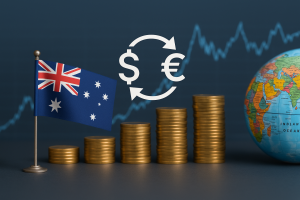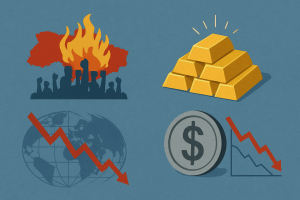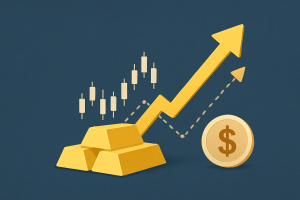Introduction
Financial trading has evolved into a global gateway for individual investors, empowering people from every background to participate in the currency, stock, and derivatives markets. Whether you are aiming to become a self-directed trader or just starting to explore the financial world, understanding the foundational aspects of trading is essential. In 2025, access to real-time market data, online platforms, and structured educational resources makes trading more accessible than ever. This article will serve as a comprehensive market guide to introduce you to the world of financial trading, with a core focus on Forex, Contracts for Difference (CFDs), and robust risk management strategies.
What Is Financial Trading?
Financial trading refers to the buying and selling of assets or financial instruments such as currencies, stocks, commodities, and derivatives with the aim of making a profit. Traders speculate on price movements, either long (buying expecting the price to rise) or short (selling expecting the price to fall), using various platforms and tools. Unlike traditional investing, which may focus on long-term gains, trading typically involves shorter timeframes and strategies driven by technical and fundamental analysis.
Two of the most accessible and widely traded instruments in financial markets are:
Forex (Foreign Exchange) – Trading currency pairs like EUR/USD, GBP/JPY, and others.
CFDs (Contracts for Difference) – Derivative products that allow traders to speculate on the price movement of various assets without owning the underlying asset.
Understanding The Forex Market
What is Forex Trading?
Forex, or foreign exchange trading, involves the exchange of one currency for another with the intent of making a profit from currency fluctuations. The Forex market is the largest and most liquid financial market in the world, with an average daily trading volume exceeding $7 trillion in 2025. Forex trading operates 24 hours a day, five days a week, and is decentralized, meaning it is not conducted through a centralized exchange like the stock market.
Currency Pairs Explained
Forex trading always involves currency pairs. The first currency in the pair is called the base currency, and the second is the quote currency. For example, in the pair EUR/USD, the euro is the base currency, and the US dollar is the quote currency. If the EUR/USD is trading at 1.1500, it means one euro equals 1.15 US dollars.
There are three main types of currency pairs:
Major Pairs – Most frequently traded (e.g., EUR/USD, GBP/USD, USD/JPY).
Minor Pairs – Pairs without the US dollar (e.g., EUR/GBP, AUD/NZD).
Exotic Pairs – Pairs involving emerging market currencies (e.g., USD/TRY, EUR/ZAR).
Key Forex Market Participants
The Forex market includes various participants:
Central Banks – Influence currency value via interest rates and policy decisions.
Commercial Banks and Financial Institutions – Facilitate large-scale transactions.
Hedge Funds and Investment Managers – Use Forex for speculative trading.
Retail Traders – Individual traders using online platforms.
Trading Platforms And Tools
In 2025, modern trading platforms offer user-friendly interfaces and analytical tools that make it easier for traders to navigate the market. Key features to expect include:
Real-Time Price Charts.
Technical Indicators (MACD, RSI, Bollinger Bands).
Economic Calendars.
Trade Simulators and Demo Accounts.
One-Click Execution.
Platforms like MetaTrader 4, MetaTrader 5, and broker-built platforms provide access to both Forex and CFD markets.
CFD Trading: A Strategic Alternative
What are CFDs?
Contracts for Difference (CFDs) are derivative financial instruments that allow traders to speculate on the rising or falling prices of fast-moving global financial markets such as shares, indices, commodities, and currencies. CFDs are popular because they enable leverage, offer access to a wide range of markets, and do not require ownership of the asset.
How CFD Trading Works?
In a CFD trade, you do not buy the asset itself. Instead, you enter into a contract with the broker to exchange the difference in the asset’s value between the time the contract is opened and when it is closed.
Buy (Go Long) – If you believe the asset will increase in value.
Sell (Go Short) – If you anticipate a decrease in value.
Profits or losses are calculated based on the change in price and the size of the trade.
Popular CFD Markets
Stock CFDs – Trade major equities like Tesla, Apple, or Amazon.
Index CFDs – Speculate on indices like the S&P 500 or NASDAQ.
Commodity CFDs – Trade oil, gold, silver, or agricultural goods.
Crypto CFDs – Available on many platforms for trading Bitcoin, Ethereum, and more.
The Role Of Leverage In Trading
Leverage allows traders to control a larger position with a smaller amount of capital. For example, with 1:50 leverage, a $1000 investment can control a $50,000 position. While this amplifies profits, it also increases the risk of significant losses. Leverage should be used cautiously, and traders must be aware of margin requirements and stop-out levels.
Building A Trading Strategy
Successful trading requires a defined plan and consistent execution. Beginners often start by learning and testing a few common strategies, such as:
Trend Following
Traders look to buy during uptrends and sell during downtrends using moving averages and support/resistance levels.
Breakout Trading
This approach focuses on entering trades when the price breaks through a defined level of support or resistance, often followed by high volatility.
Range Trading
When markets lack a clear trend, traders capitalize on price bouncing between support and resistance levels.
Technical Vs. Fundamental Analysis
Technical Analysis
This involves studying past market data, primarily price and volume, using charts and technical indicators to forecast future movements. Common tools include:
Moving Averages.
Relative Strength Index (RSI).
Fibonacci Retracements.
MACD (Moving Average Convergence Divergence).
Fundamental Analysis
Focuses on understanding the macroeconomic factors and news events that influence market prices. Key indicators include:
Interest rate decisions.
Inflation and employment data.
GDP reports.
Geopolitical developments.
Most successful traders use a combination of both analysis methods to inform their decisions.
Risk Management Essentials
One of the most critical components of trading success is risk management. It ensures that a single losing trade does not significantly impact your capital.
Setting Stop Losses and Take Profits
A stop loss limits your losses by automatically closing a trade when the price hits a predefined level. A take profit order locks in gains when a trade reaches a specified target. Using these tools helps you manage risk on every position.
Position Sizing
Never risk more than a small percentage of your total capital on a single trade. A common rule is the 1% rule – do not risk more than 1% of your account balance per trade.
Risk-to-Reward Ratio
Before entering any trade, evaluate if the potential reward outweighs the risk. A 2:1 or 3:1 ratio (reward is two or three times the risk) is considered ideal for long-term profitability.
Psychology Of Trading
Emotions often undermine trading performance. Greed, fear, impatience, and overconfidence can all lead to poor decisions. Professional traders cultivate discipline and emotional control through:
Following a trading plan.
Keeping a journal to track trades and reflect.
Taking breaks during periods of volatility.
Accepting that losses are a normal part of the process.
Choosing The Right Broker
A reliable broker is crucial to your success. Consider the following when selecting a trading platform:
Regulation – Ensure the broker is licensed by a recognized financial authority.
Spreads and Fees – Low-cost trading is essential for profitability.
Leverage Options – Look for reasonable and transparent leverage offerings.
Customer Support – 24/7 assistance can be vital, especially in fast-moving markets.
Platform Interface – Ensure the platform is easy to use and offers robust tools.
Continuous Learning And Practice
Learning to trade successfully is a journey that requires patience, practice, and continual learning. The best traders stay updated with market news, test new strategies, and refine their skills over time. Use demo accounts to practice without risk, attend webinars, and study courses from trusted providers.
Conclusion
In 2025, financial trading is more accessible than ever, but the path to success is not guaranteed. By building a solid foundation in Forex and CFD trading and mastering risk management techniques, new traders can enter the market with confidence. Educational resources like market guides, video tutorials, and structured courses provide a significant advantage.
If you’re ready to begin your trading journey, start with learning the fundamentals, practicing in a risk-free environment, and staying committed to growth and discipline. Financial freedom through trading is achievable — but only with knowledge, strategy, and patience.


